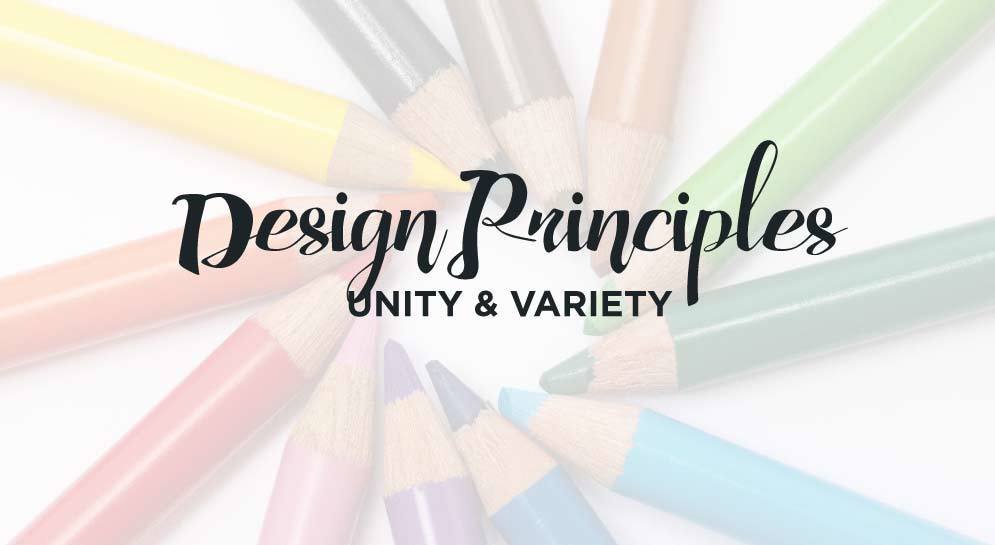“Without unity, an image is chaotic and 'unreadable;' without variety it is dull and uninteresting” says Donna from nwrain.net. Unity and variety in a composition are said to be the most important principles of design. This is because these two principles are what is needed to hold a composition together. Good design is achieved by a balance of these two principles. Elements within a composition need to be similar enough for us to perceive that they belong together, but different enough to be interesting.
More...
Unity
The stakes are high with this principle. It is often thought that if a composition is not unified, it is not successful. When a composition is unified, its differing elements are all working together to support the design as a whole.
Unity is whether a piece of art or a design is harmonious or cohesive. If you've ever heard of gestalt theory, this is where it comes in. Gestalt theory, stated simply, is that the whole is greater than the sum of its parts. Basically, humanity tries to make order out of chaos. Take for example, a car. The car itself is greater than merely the metal, the mechanics, and motor. In viewing the “whole,” or the car in this example, a cognitive process takes place. The mind makes the transition from realizing the individual parts to comprehending the car as a whole.
In a painting, we comprehend the whole image instead of just seeing the paint, the canvas, and the brush. This is humanity's way of visually and psychologically organizing information. We do this by grouping elements together into new wholes, and we do this in several ways.
Proximity
Proximity is grouping by nearness. The closer the elements are together, the more likely it is that they are seen as a group.
Repetition
Repetition is grouping by similarity. If elements are similar, they are perceived as related, and thus, grouped together. Any element can be repeated – line, shape, color, texture, or value. Repeating other features can also create unity such as using the same angle or size. Repetition is one of the simplest and most effective ways to unify a design.

Alignment
Alignment is another way to accomplish unity throughout a composition. Though simple, it is not always easy to accomplish. Alignment is the lining up of the edges of an object, and this allows the eye to group these elements together. If you are OCD, you may have some serious issues when alignment is incorrect.
Continuation
Continuation is grouping by connection. It is when something (a line, a curve, an edge) connects one element to another. A viewer’s eye will follow this continuation or connection smoothly, and will group elements because of it. Continuation doesn't have to be an actual connection; implied links are also an example.
Variety
If unity is what holds an image together, variety is what makes it worth looking at. There are many ways to create variety just as there are many ways to create unity. Creating variations of different elements is one such way.
- Line: varying weight, angle, or length
- Shape: changing up the kind of shape (i.e. amorphous or geometric) as well as the size, color, orientation, texture, etc.
- Color: using diversity in the hue, value, or saturation
- Value: varying the lightness or darkness
- Texture: is it rough or is it smooth?
Conclusion
If unity is what brings a composition together and variety is what makes it interesting, we can very easily see how these two principles are extraordinarily important to the success of a work of art. Not only does this have implications for a piece of art, it also affects marketing collateral and forms. Unity and variety influence whether a consumer willingly picks up your material or whether, begrudgingly, they fill out a form. Some material is nicer to look at; some forms more unpleasant than others to fill out.
So think about it. We have learned the basic elements and principles of design and many implications from them. Hopefully you learned to distinguish good art from bad art. And I hope you realize how these principles often influence buying decisions.
Not many of us find it difficult to write a sentence. This is because we were trained. We went to school to learn the principles and have done it thousands of times. Design is like this. Once we learn the principles, we can accomplish design that is well done. Throughout this series, I hope that you learned more about how to complete designs more successfully.
What do you think? Why do you think unity and variety are important? Please leave a comment below and let me know your thoughts, and if you are thinking that you need help with this, work with us. We would be happy to work with you to make your ideas come to life.
If you are a small business owner or entrepreneur who wants to learn graphic design yourself, then the course below will teach you the skills and resources you need to know to make your company memorable..


hello! this is a great blog and i often take pleasure in the information posted right here. Bookmarked and shared. Many thanks yet again!
Thank you for the shares Genia! I appreciate it!